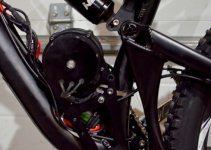jbond
100 W
- Joined
- Oct 1, 2010
- Messages
- 204
I'm trying to understand the differences between the RC style controllers from people like Turnigy and the E-Bike style controllers like the one's that Lyen modifies. Now clearly the E-Bike controllers have a lot of extra capabilities with cruise, regen, brake cutoffs, PAS sensors and so on. What's puzzling is that the RC controllers seem to be designed to run at lower voltages but much higher continuous currents. However, they don't seem to be able to cope with high throttle low speed.
I'm guessing here that the problem is to do with the phase current multiplication. An RC duty cycle normally involves limited torque but very rapid spin up. This is very different from a bicycle duty cycle where it's easy to find yourself accelerating from standstill or struggling up a hill. So an RC motor typically gets through the high throttle low speed period very quickly, where a bicycle can be stuck in that regime for quite long periods. So an RC ESC can have FETs and heat management designed around 24V-70A continuous but doesn't have to handle the 24V-200A that the phase current will peak at. Where a 36v-20A e-bike controller must be able to handle 36v-45V for quite long periods.
The high end Turnigy ESC are programmable. Is there any detail on the web of what can be programmed? Do they have LVC, battery current limiting, phase current limiting and so on?
[moderator edit to fix title]
I'm guessing here that the problem is to do with the phase current multiplication. An RC duty cycle normally involves limited torque but very rapid spin up. This is very different from a bicycle duty cycle where it's easy to find yourself accelerating from standstill or struggling up a hill. So an RC motor typically gets through the high throttle low speed period very quickly, where a bicycle can be stuck in that regime for quite long periods. So an RC ESC can have FETs and heat management designed around 24V-70A continuous but doesn't have to handle the 24V-200A that the phase current will peak at. Where a 36v-20A e-bike controller must be able to handle 36v-45V for quite long periods.
The high end Turnigy ESC are programmable. Is there any detail on the web of what can be programmed? Do they have LVC, battery current limiting, phase current limiting and so on?
[moderator edit to fix title]


